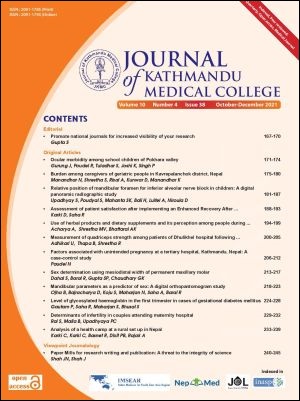Sex determination using mesiodistal width of permanent maxillary molar
DOI:
https://doi.org/10.3126/jkmc.v10i4.43866Keywords:
Forensic dentistry, Mesiodistal width, Morphometry, Nepal, Sexual dimorphismAbstract
Background: Teeth are valuable material for forensic investigations since they are the strong and stable human tissue that is resistant to physical damage. Sex determination, which is usually the first stage in the human identification process, is one of the essential criteria of biological identity.
Objectives: To evaluate the potential of mesiodistal width of permanent maxillary molar in sex determination.
Methods: This analytical cross-sectional study was done in 120 dental casts prepared for different dental treatment purposes in Tribhuvan University Teaching Hospital, Institute of Medicine, Maharajgunj, Kathmandu, Nepal from 5th October, 2021 to 5th November, 2021. Convenience sampling technique was used. The mesiodistal dimension of the permanent maxillary molar was measured with the help of a digital vernier caliper (Digimatic Eco, Precise, India). The data were entered in a Microsoft Excel sheet and analysed statistically using Statistical Package for Social Sciences Statistics Version 21.
Results: The mean age of the patients was 21.05 ± 5.64 years. The mesiodistal dimension of maxillary first molar in males and females were not statistically significant on both the right and the left sides of the jaw. The sexual dimorphism percentage was 0.893% and 0.606% in right and left maxillary first molar respectively. Similarly, the frequency was 0.018 and 0.267 in right and left maxillary first molar respectively.
Conclusion: Mesiodistal dimension of maxillary first molar did not significantly differ between the right and left sides of the jaw. This study could not establish sexual dimorphism among the right and left sides of the jaw.
Downloads
Downloads
Published
How to Cite
Issue
Section
License
Copyright © Journal of Kathmandu Medical College
The ideas and opinions expressed by authors or articles summarized, quoted, or published in full text in this journal represent only the opinions of the authors and do not necessarily reflect the official policy of Journal of Kathmandu Medical College or the institute with which the author(s) is/are affiliated, unless so specified.
Authors convey all copyright ownership, including any and all rights incidental thereto, exclusively to JKMC, in the event that such work is published by JKMC. JKMC shall own the work, including 1) copyright; 2) the right to grant permission to republish the article in whole or in part, with or without fee; 3) the right to produce preprints or reprints and translate into languages other than English for sale or free distribution; and 4) the right to republish the work in a collection of articles in any other mechanical or electronic format.




